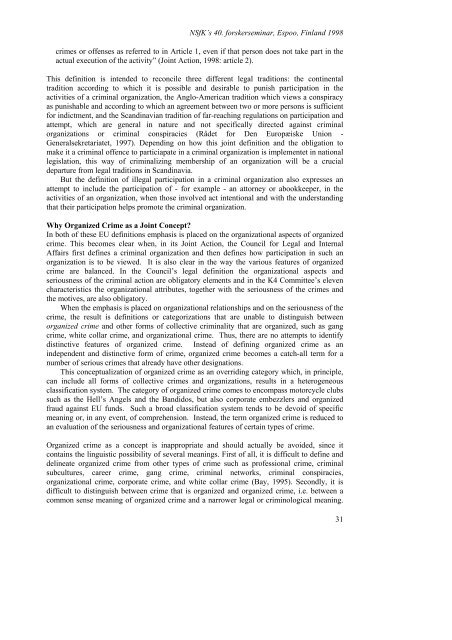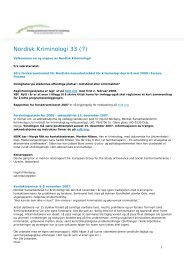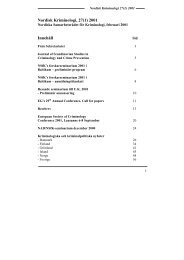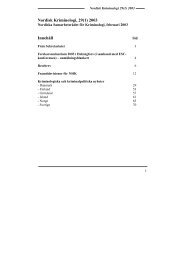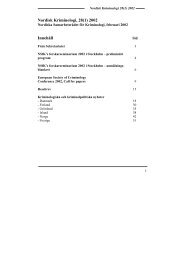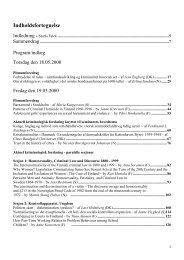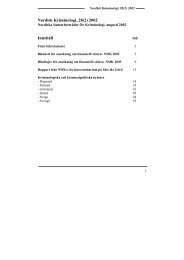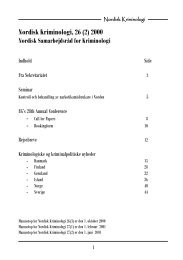Organised Crime & Crime Prevention - what works? - Scandinavian ...
Organised Crime & Crime Prevention - what works? - Scandinavian ...
Organised Crime & Crime Prevention - what works? - Scandinavian ...
Create successful ePaper yourself
Turn your PDF publications into a flip-book with our unique Google optimized e-Paper software.
NSfK’s 40. forskerseminar, Espoo, Finland 1998<br />
crimes or offenses as referred to in Article 1, even if that person does not take part in the<br />
actual execution of the activity” (Joint Action, 1998: article 2).<br />
This definition is intended to reconcile three different legal traditions: the continental<br />
tradition according to which it is possible and desirable to punish participation in the<br />
activities of a criminal organization, the Anglo-American tradition which views a conspiracy<br />
as punishable and according to which an agreement between two or more persons is sufficient<br />
for indictment, and the <strong>Scandinavian</strong> tradition of far-reaching regulations on participation and<br />
attempt, which are general in nature and not specifically directed against criminal<br />
organizations or criminal conspiracies (Rådet for Den Europæiske Union -<br />
Generalsekretariatet, 1997). Depending on how this joint definition and the obligation to<br />
make it a criminal offence to particiapate in a criminal organization is implementet in national<br />
legislation, this way of criminalizing membership of an organization will be a crucial<br />
departure from legal traditions in Scandinavia.<br />
But the definition of illegal participation in a criminal organization also expresses an<br />
attempt to include the participation of - for example - an attorney or abookkeeper, in the<br />
activities of an organization, when those involved act intentional and with the understanding<br />
that their participation helps promote the criminal organization.<br />
Why Organized <strong>Crime</strong> as a Joint Concept?<br />
In both of these EU definitions emphasis is placed on the organizational aspects of organized<br />
crime. This becomes clear when, in its Joint Action, the Council for Legal and Internal<br />
Affairs first defines a criminal organization and then defines how participation in such an<br />
organization is to be viewed. It is also clear in the way the various features of organized<br />
crime are balanced. In the Council’s legal definition the organizational aspects and<br />
seriousness of the criminal action are obligatory elements and in the K4 Committee’s eleven<br />
characteristics the organizational attributes, together with the seriousness of the crimes and<br />
the motives, are also obligatory.<br />
When the emphasis is placed on organizational relationships and on the seriousness of the<br />
crime, the result is definitions or categorizations that are unable to distinguish between<br />
organized crime and other forms of collective criminality that are organized, such as gang<br />
crime, white collar crime, and organizational crime. Thus, there are no attempts to identify<br />
distinctive features of organized crime. Instead of defining organized crime as an<br />
independent and distinctive form of crime, organized crime becomes a catch-all term for a<br />
number of serious crimes that already have other designations.<br />
This conceptualization of organized crime as an overriding category which, in principle,<br />
can include all forms of collective crimes and organizations, results in a heterogeneous<br />
classification system. The category of organized crime comes to encompass motorcycle clubs<br />
such as the Hell’s Angels and the Bandidos, but also corporate embezzlers and organized<br />
fraud against EU funds. Such a broad classification system tends to be devoid of specific<br />
meaning or, in any event, of comprehension. Instead, the term organized crime is reduced to<br />
an evaluation of the seriousness and organizational features of certain types of crime.<br />
Organized crime as a concept is inappropriate and should actually be avoided, since it<br />
contains the linguistic possibility of several meanings. First of all, it is difficult to define and<br />
delineate organized crime from other types of crime such as professional crime, criminal<br />
subcultures, career crime, gang crime, criminal net<strong>works</strong>, criminal conspiracies,<br />
organizational crime, corporate crime, and white collar crime (Bay, 1995). Secondly, it is<br />
difficult to distinguish between crime that is organized and organized crime, i.e. between a<br />
common sense meaning of organized crime and a narrower legal or criminological meaning.<br />
31


